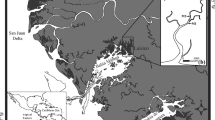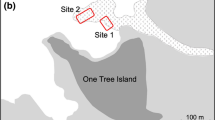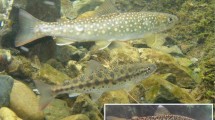Abstract
This study tracked the seasonal distribution and winter habitat selection of the mummichog, Fundulus heteroclitus (Linnaeus), in a Cape Cod, Massachusetts salt marsh. Fish (mean size = 43.1 mm total length, range = 10–93 mm) were collected with a 1 m2 throw trap and by excavating sediments. In fall, F. heteroclitus began migrating upstream in creeks and eventually moved into upstream pools where they remained throughout winter. F. heteroclitus burrowed into the sediments of these pools at a density of 0.5 fish m−2, but was not found burrowed in the sediments of downstream pools or any creeks. Sediments in upstream pools were composed of a higher proportion of fine-grained particles and organic content than other marsh pools and creeks, and winter temperatures in upstream pool sediments remained above 1 °C. Temperatures in the water column and sediments of downstream pools regularly dropped below −1.8 °C, exceeding the lethal limit for F. heteroclitus. These results support other recent work showing that F. heteroclitus migrates upstream in salt marshes in fall and overwinters in salt marsh pools. Moreover, this study demonstrates that F. heteroclitus does not utilize all available pools as overwintering habitat but apparently selects pools with sediments that offer a thermal refuge from lethal winter temperatures.
Similar content being viewed by others
References
Able K.W. and Fahay M.P. 1998. The first year in the life of estuarine fishes in the middle Atlantic bight. Rutgers University Press, New Jersey.
Bean T.H. 1902. The fishes of Long Island Sound, with notes upon their distribution, common names, habits, and rate of growth. N.Y. Forage Fish Game Commission Annual Report 6 373–478.
Chidester F.E. 1920. The behavior of Fundulus heteroclitus on the heterosalt marshes of New Jersey. American Naturalist 54: 551–557.
Dean W.E. Jr 1974. Determination of carbonate and organic matter in calcareous sediments and sedimentary rocks by loss on ignition: comparison with other methods. Journal of Sedimentary Petrology 44: 242–248.
Frederick P.C. and Loftus W.F. 1993. Responses of marsh fishes and breeding wading birds to low temperatures: a possible behavioral link between predator and prey. Estuaries16: 216– 222.
Fritz E.S., Meredith W.H. and Lotrich V.A. 1975. Fall and winter movements and activity level of the mummichog, Fundulus heteroclitus, in a tidal creek. Chesapeake Science 16: 211–215.
Hardy J.D. Jr 1978. Development of fishes of the Mid-Atlantic Bight: An atlas of egg, larval and juvenile stages. Anguillidae through Syngnathidae. Biological Services Program. US Fish and Wildlife Service FWS/OBS-789/ 12.455. US Government Printing Office, Washington.
Jordan F., Coyne S. and Trexler J.C. 1997. Sampling fishes in vegetated habitats: effects of habitat structure on sampling 2 characteristics of the 1-m throw trap. Transactions of the American Fisheries Society 126: 1012–1020.
Kneib R.T. 1981. Size-specific effects of density on the growth, fecundity and mortality of the fish Fundulus heteroclitus in an intertidal salt marsh. Marine Ecology Progress Series 6: 203– 212.
Rozas L.P. and Minello T.J. 1997. Estimating densities of small fishes and decapod crustaceans in shallow estuarine habitats: a review of sampling design with focus on gear selection. Estuaries 20: 199–213.
Smith K.J. and Able K.W. 1994. Salt-marsh tide pools as winter refuges for the mummichog,Fundulus heteroclitus, in New Jersey. Estuaries 17: 226–234.
Weisberg S.B. and Lotrich V.A. 1986. Food limitation of a Dela-ware salt marsh population of the mummichog,Fundulus heterosalt clitus (L.). Oecologia 68: 168–173.
Weinstein M.P., Weiss S.L. and Walters M.F. 1980. Multiple determinants of community structure in shallow marsh habitats, Cape Fear Estuary, North Carolina, USA. Marine Biology 58: 227–243.
Weiss H.M. 1995. Marine animals of southern New England and New York. State Geological and Natural History Survey of Connecticut, Bulletin 115
Author information
Authors and Affiliations
Rights and permissions
About this article
Cite this article
Raposa, K. Overwintering habitat selection by the mummichog, Fundulus Heteroclitus, in a Cape Cod (USA) salt marsh. Wetlands Ecology and Management 11, 175–182 (2003). https://doi.org/10.1023/A:1024244317173
Issue Date:
DOI: https://doi.org/10.1023/A:1024244317173




